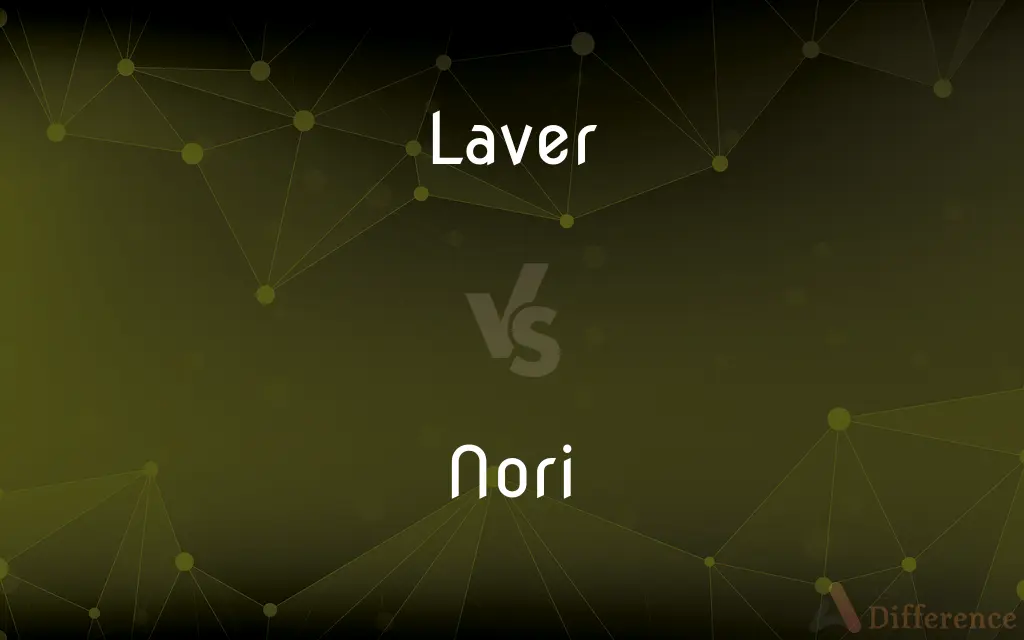Laver vs. Nori — What's the Difference?
By Tayyaba Rehman — Updated on November 3, 2023
Laver refers broadly to edible seaweed, while nori is a specific type of laver, often used in Japanese cuisine, particularly for sushi.

Difference Between Laver and Nori
Table of Contents
ADVERTISEMENT
Key Differences
Laver encompasses various types of edible seaweed across different cultures. It is harvested for its nutritional value. Nori, on the other hand, is specifically a Japanese term for a certain edible seaweed, commonly used as a sushi wrap.
Laver is used in various regional cuisines and can be prepared in different ways, such as boiled and served with butter in Welsh cuisine. Nori is most widely recognized as the dry, pressed sheets used in sushi rolls and onigiri.
In terms of culinary applications, laver may refer to seaweeds that are not pressed into sheets and are used in dishes like laverbread. Nori is typically sold as thin, dried sheets and has a distinctive taste and a crisp texture when fresh.
While all nori is laver, not all laver is considered nori. Nori sheets are a processed form of the raw laver seaweed, specifically the Porphyra species.
Lastly, laver is often associated with Atlantic coasts, where it has been consumed for centuries. Nori, although derived from similar species of seaweed, is most associated with Japanese cuisine and is integral to its traditional food practices.
ADVERTISEMENT
Comparison Chart
Definition
A type of edible seaweed broadly.
A specific type of seaweed used in Japanese cuisine.
Cuisine
Used in various world cuisines.
Primarily used in Japanese cuisine.
Form
Can be fresh, boiled, or baked.
Typically dried and pressed into sheets.
Cultural Association
Common in Welsh and other Atlantic cuisines.
Strongly associated with Japanese food culture.
Use
Can be an ingredient or garnish.
Used mostly for wrapping sushi or as a condiment.
Compare with Definitions
Laver
Edible seaweed
She added fresh laver to the soup for extra nutrients.
Nori
Japanese seaweed
Nori is essential for making onigiri.
Laver
A Welsh delicacy
For breakfast, he had toast with laverbread.
Nori
Dried seaweed sheets
She packed a snack of nori for her child.
Laver
A source of iodine
Laver, rich in iodine, is a staple in coastal diets.
Nori
A crispy condiment
Chopped nori was used to top the udon.
Laver
Seaweed used in cooking
Laver can be boiled and eaten like spinach.
Nori
Seaweed for flavoring
Nori adds a unique flavor to dishes.
Laver
A garnish
She sprinkled dried laver on top of the rice.
Nori
Sushi wrapper
He rolled the sushi in a sheet of nori.
Laver
A large basin used in the ancient Jewish Temple by a priest for ablutions before making a sacrificial offering.
Nori
Nori (海苔) is a dried edible seaweed used in Japanese cuisine, made from species of the red algae genus Pyropia including P. yezoensis and P. tenera. It has a strong and distinctive flavor, and is often used to wrap rolls of sushi or onigiri (rice balls).
Laver
(Archaic) A vessel or basin, especially one used for washing.
Nori
An edible, dried preparation of red algae of the genus Porphyra.
Laver
Any of several dried edible seaweeds, especially red algae of the genus Porphyra and green algae of the genus Ulva.
Nori
A type of seaweed, a red alga, laver (genus Pyropia, including species Pyropia yezoensis and Pyropia tenera).
Laver
A red alga/seaweed, Porphyra umbilicalis (syn. Porphyra laciniata), eaten as a vegetable.
Nori
The seaweed, chopped and formed into sheets, used in the preparation of sushi.
Laver
Other seaweeds similar in appearance or use, especially:
Nori
A type of dried seaweed, pressed into sheets and used as a seasoning or as a wrapper for sushi.
Laver
Porphyra vulgaris
Laver
One who laves: a washer.
Laver
Where one laves, a washroom, particularly a lavatorium, the washing area in a monastery.
Laver
That which laves, particularly a washbasin.
Laver
A vessel for washing; a large basin.
Laver
A large brazen vessel placed in the court of the Jewish tabernacle where the officiating priests washed their hands and feet.
Laver
That which washes or cleanses.
Laver
One who laves; a washer.
Laver
The fronds of certain marine algæ used as food, and for making a sauce called laver sauce. Green laver is the Ulva latissima; purple laver, Porphyra laciniata and Porphyra vulgaris. It is prepared by stewing, either alone or with other vegetables, and with various condiments; - called also sloke, or sloakan.
Laver
Australian tennis player who in 1962 was the second man to win the Australian and French and English and United States singles titles in the same year; in 1969 he repeated this feat (born in 1938)
Laver
(Old Testament) large basin used by a priest in an ancient Jewish temple to perform ritual ablutions
Laver
Edible red seaweeds
Laver
Seaweed with edible translucent crinkly green fronds
Common Curiosities
What is laver?
Laver is a type of edible seaweed found along Atlantic coasts and used in various cuisines.
Is laver used outside of Japanese cuisine?
Yes, laver is used in many coastal cultures, including Welsh cuisine.
What is nori?
Nori is a specific type of laver processed into thin sheets, commonly used in Japanese cuisine.
Are laver and nori the same?
Nori is a form of laver but not all laver is nori; "nori" specifically refers to the dried sheets used in sushi.
What nutrients are in laver?
Laver is high in vitamins A, C, B12, and iodine.
Is laverbread actually bread?
No, laverbread is a traditional Welsh dish made from laver, not actual bread.
Can I substitute nori for laver?
It depends on the dish, as they have different forms and culinary uses.
Is nori always made into sheets?
Yes, nori is typically processed into thin, dried sheets.
How does the taste of laver compare to nori?
Laver has a milder taste compared to nori, which has a stronger, umami flavor.
How should I store nori?
Nori should be stored in a cool, dry place to maintain its crispness.
Can you eat laver raw?
Yes, some types of laver can be eaten raw, depending on the variety and preparation.
How do you prepare laver?
Laver can be boiled, fried, or eaten as is, depending on the type.
Is nori vegan?
Yes, nori is vegan as it is made from seaweed.
Can I make my own nori?
Making nori requires a specific process and usually specialized equipment.
Are there different types of nori?
Yes, nori comes in different grades, with variations in quality, flavor, and price.
Share Your Discovery

Previous Comparison
Mesmerized vs. Spellbound
Next Comparison
Letter vs. MailAuthor Spotlight
Written by
Tayyaba RehmanTayyaba Rehman is a distinguished writer, currently serving as a primary contributor to askdifference.com. As a researcher in semantics and etymology, Tayyaba's passion for the complexity of languages and their distinctions has found a perfect home on the platform. Tayyaba delves into the intricacies of language, distinguishing between commonly confused words and phrases, thereby providing clarity for readers worldwide.















































